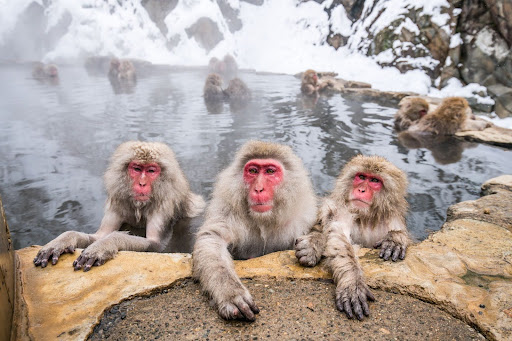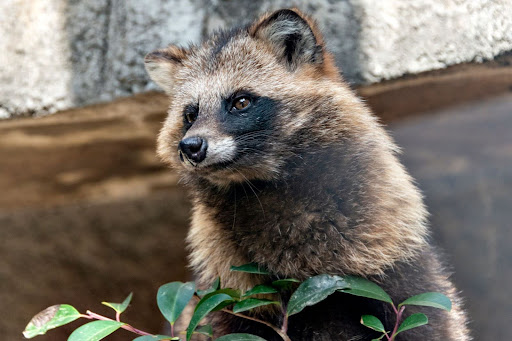From the snowy peaks of Hokkaido to the subtropical islands of Okinawa, Japan’s landscape is as diverse as its wildlife. With creatures that both inspire legends and play vital roles in their ecosystems, here are ten remarkable animals that you might just encounter on a journey through Japan.
Japanese Macaque (Snow Monkey)
One of Japan’s most iconic animals, the Japanese macaque, or snow monkey, is known for soaking in hot springs during winter—a habit that makes them popular among visitors in Nagano’s Jigokudani Monkey Park.
With their red faces and thick fur, these monkeys are iconic. Adapted to Japan’s cold northern regions, this makes them the world’s northernmost non-human primates. No trip to Japan is complete without watching them basking in the hot steam against a snowy landscape. They’re quite a social bunch, often huddling in large groups for warmth.

Sika Deer
You can’t visit Nara without spotting the friendly sika deer wandering through parks and bowing politely to visitors—well, politely enough when they’re offered treats! Sika deer hold a special place in Japanese culture, believed to be sacred messengers of the gods according to Shinto beliefs.
While Nara’s deer may be famous, sika also live across Japan’s forests and mountains. With their distinctive white-spotted coats, these deer are a delightful symbol of Japan’s harmony between nature and urban life.

Red-Crowned Crane
The elegant red-crowned crane, or tancho, is a symbol of longevity and good fortune in Japan. Hokkaido is the place to see these majestic birds, especially during winter when they gather in wetlands. Their graceful, elaborate courtship dance and striking red head crowns make them stand out.
Shockingly, red-crowned cranes were once nearly extinct, however conservation efforts have brought them back from the brink. Today, they remain one of Japan’s most cherished animals.

Japanese Giant Salamander
A creature straight out of prehistoric times, the Japanese giant salamander is one of the world’s largest amphibians, reaching lengths of up to five feet. These salamanders live in cool, fast-flowing rivers and streams in western Japan. As they’re are nocturnal, sightings of them rare making it all the more special.
The salamanders are highly protected as a near-threatened species and play a critical role in maintaining the river ecosystem. With their wrinkly, almost otherworldly appearance, these giants are an unforgettable part of Japan’s wildlife heritage.

Asian Black Bear
Also known as moon bears for the distinct white crescent on their chests, Asian black bears roam Japan’s mountainous forests. They’re generally shy and elusive, inhabiting the forests of Honshu, Shikoku, and Kyushu.
While these bears are essential for seed dispersal and ecosystem balance, their habitat is at risk due to deforestation. Although spotting a wild bear is rare, it’s possible to see them in protected parks, and their presence underscores Japan’s commitment to conservation.

Japanese Serow
The Japanese serow is a unique goat-antelope hybrid. These animals were once endangered but have made a significant comeback thanks to strong protective laws.
Living in forested mountain areas, serows are known for their sure-footedness and calm demeanor, often seen balancing on steep rocky cliffs.

Tanuki (Japanese Raccoon Dog)
Tanuki are common in Japanese folklore, where they’re known as playful shapeshifters and mischief-makers. These raccoon dogs are nocturnal and thrive in both forests and urban areas, adding a dash of folklore to daily life.
Statues of tanuki, often with exaggerated features, are common outside restaurants and shops given that they are a symbol of good fortune. The real animals have bushy tails and black markings around their eyes. Their cultural presence as tricksters makes them a cherished part of Japanese folklore.

Japanese Flying Squirrel
Both the Japanese dwarf flying squirrel and the larger Japanese giant flying squirrel can be found in Japan’s forests. These adorable creatures are known for gliding between trees using flaps of skin that extend from their forelimbs to their hind limbs.
They’re nocturnal, making them tricky to spot, but their large eyes, rounded ears, and impressive gliding skills have earned them a special place in Japanese wildlife photography and local lore.

Ryukyu Flying Fox
The Ryukyu flying fox, a large bat native to Japan’s southern islands, is an animal almost unlike any other. Found in Okinawa and the Ryukyu archipelago, these gentle, fruit-eating bats roost in trees by day and forage at night.
The Ryukyu flying fox is classified as vulnerable due to habitat loss, and conservation efforts are crucial for their continued survival, as they’re essential to the health of island ecosystems.

Travelling across Japanese
From the highlands of Hokkaido to the forests of Honshu and the tropical islands of Okinawa, Japan’s wildlife showcases its incredible biodiversity and cultural heritage. If you’re keen to explore these animals in their natural habitats, the Japan Rail Pass is a perfect companion, helping travellers easily hop from city to city or head out into the countryside.
Whether you’re catching sight of a red-crowned crane’s dance or spotting a gliding flying squirrel, Japan’s wildlife offers an unforgettable peek into the country’s natural and cultural wonders.
Guest Blog
This original guest blog has been written in collaboration with author Oli from Journalistic. Images are credited as per instructions from Journalistic. Just One for the Road accepts no responsibility for the text or the use of these photos. Should there be any dispute the page will be taken down immediately.
For more information on trips to Japan check out my blogs on Japan.







